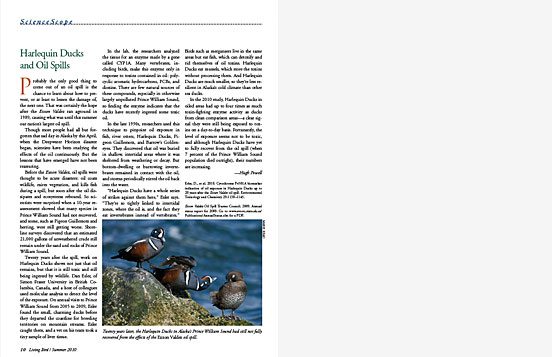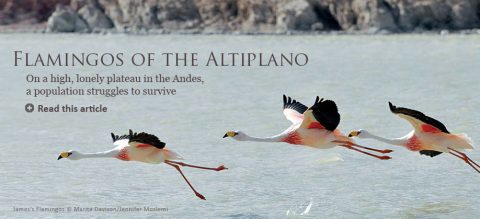Harlequin Ducks and Oil Spills
by Hugh Powell
July 15, 2010
Probably the only good thing to come out of an oil spill is the chance to learn about how to prevent, or at least to lessen the damage of, the next one. That was certainly the hope after the Exxon Valdez ran aground in 1989, causing what was until this summer our nation’s largest oil spill.
Though most people had all but forgotten that sad day in Alaska by this April, when the Deepwater Horizon disaster began, scientists have been studying the effects of the oil continuously. But the lessons that have emerged have not been reassuring.
Before the Exxon Valdez, oil spills were thought to be acute disasters: oil coats wildlife, mires vegetation, and kills fish during a spill, but soon after the oil dissipates and ecosystems rebound. So scientists were surprised when a 10-year reassessment showed that many species in Prince William Sound had not recovered, and some, such as Pigeon Guillemots and herring, were still getting worse. Shoreline surveys discovered that an estimated 21,000 gallons of unweathered crude still remain under the sand and rocks of Prince William Sound.
Twenty years after the spill, work on Harlequin Ducks shows not just that oil remains, but that it is still toxic and still being ingested by wildlife. Dan Esler, of Simon Fraser University in British Columbia, Canada, and a host of colleagues used molecular analysis to detect the level of the exposure. On annual visits to Prince William Sound from 2005 to 2009, Esler found the small, charming ducks before they departed the coastline for breeding territories on mountain streams. Esler caught them, and a vet on his team took a tiny sample of liver tissue.
In the lab, the researchers analyzed the tissue for an enzyme made by a gene called CYP1A. Many vertebrates, including birds, make this enzyme only in response to toxins contained in oil: polycyclic aromatic hydrocarbons, PCBs, and dioxins. There are few natural sources of these compounds, especially in otherwise largely unpolluted Prince William Sound, so finding the enzyme indicates that the ducks have recently ingested some toxic oil.
In the late 1990s, researchers used this technique to pinpoint oil exposure in fish, river otters, Harlequin Ducks, Pigeon Guillemots, and Barrow’s Goldeneyes. They discovered that oil was buried in shallow, intertidal areas where it was sheltered from weathering or decay. But bottom-dwelling or burrowing invertebrates remained in contact with the oil, and storms periodically stirred the oil back into the water.
“Harlequin Ducks have a whole series of strikes against them here,” Esler says. “They’re so tightly linked to intertidal zones, where the oil is, and the fact they eat invertebrates instead of vertebrates.” Birds such as mergansers live in the same areas but eat fish, which can detoxify and rid themselves of oil toxins. Harlequin Ducks eat mussels, which store the toxins without processing them. And Harlequin Ducks are much smaller, so they’re less resilient in Alaska’s cold climate than other sea ducks.
In the 2010 study, Harlequin Ducks in oiled areas had up to four times as much toxin-fighting enzyme activity as ducks from clean comparison areas—a clear signal they were still being exposed to toxins on a day-to-day basis. Fortunately, the level of exposure seems not to be toxic, and although Harlequin Ducks have yet to fully recover from the oil spill (when 7 percent of the Prince William Sound population died outright), their numbers are increasing.

All About Birds
is a free resource
Available for everyone,
funded by donors like you
American Kestrel by Blair Dudeck / Macaulay Library



